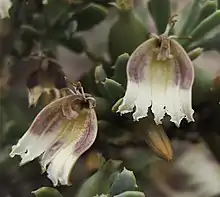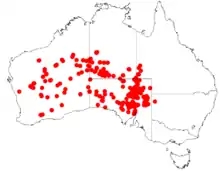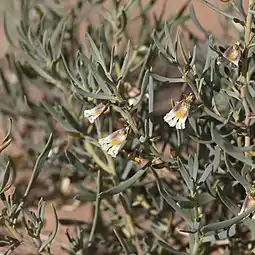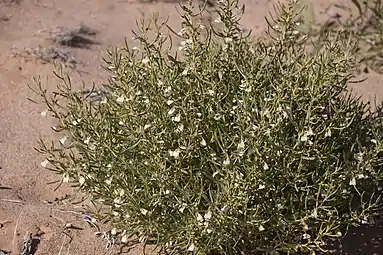| Scaevola collaris | |
|---|---|
 | |
| Scientific classification | |
| Kingdom: | Plantae |
| Clade: | Tracheophytes |
| Clade: | Angiosperms |
| Clade: | Eudicots |
| Clade: | Asterids |
| Order: | Asterales |
| Family: | Goodeniaceae |
| Genus: | Scaevola |
| Species: | S. collaris |
| Binomial name | |
| Scaevola collaris | |
 | |
| Occurrence data from AVH | |
| Synonyms[3] | |
Scaevola collaris is a shrub in the family Goodeniaceae[1] and its native range is five mainland states/territories of Australia: the Northern Territory, New South Wales, South Australia, Queensland and Western Australia.[4]
It is an endangered species in New South Wales.[5]
Description
Scaevola collaris is an erect shrub, growing to 0.5 m.[4][6][7] The stems are erect and smooth.[4][6] The leaves are sessile (i.e., have no stalk), succulent and smooth, and 1-8.5 cm long by 1–9 mm wide.[4][6] The flowers occur in terminal spikes or are solitary or clustered in the axils.[4][6]
The sepals are ovate to triangular, smooth and almost free.[4][6] The corolla is 6-17mm long, smooth on the outside with short hairs on the inside, and yellow to cream or mauve.[4][6] The anthers are free.[7] The ovary is inferior[7] and from 5–20 mm long, is two-celled and usually has a beak and a foot.[6]
It flowers mostly from May to November.[4]
Distribution
It is found on saline soils in the arid parts of the south of Western Australia, the south of the Northern Territory, South Australia, western Queensland and north-western New South Wales.[4]
Naming
It was first described in 1859 by Ferdinand von Mueller,[1][2] and the specific epithet, collaris, comes from the Latin, collaris (having a collar).[8] It was transferred to the genus, Goodenia, in 2020 by Kelly Anne Shepherd and others.[9] Goodenia collaris is the name accepted by the WA herbarium.[10]
Gallery
References
- 1 2 3 "Scaevola collaris". Australian Plant Name Index, IBIS database. Centre for Plant Biodiversity Research, Australian Government. Retrieved 27 July 2019.
- 1 2 Mueller, F.J.H. von (1859) Report on the Plants Collected During Mr. Babbage's Expedition into the North West Interior of South Australia in 1858: 15. Retrieved 27 July 2019.
- ↑ "Scaevola collaris F.Muell. | Plants of the World Online | Kew Science". Plants of the World Online. Retrieved 27 July 2019.
- 1 2 3 4 5 6 7 8 9 Flora of Australia: Scaevola collaris. Retrieved 27 July 2019.
- ↑ "Scaevola collaris, PlantNET - FloraOnline". plantnet.rbgsyd.nsw.gov.au. Retrieved 28 July 2019.
- 1 2 3 4 5 6 7 "Fact sheet for Scaevola collaris". www.flora.sa.gov.au. EFloraSA: Electronic Flora of South Australia. Retrieved 28 July 2019.
- 1 2 3 Western Australian Herbarium, Biodiversity and Conservation Science. "Scaevola collaris, FloraBase—the Western Australian Flora". florabase.dpaw.wa.gov.au. Retrieved 28 July 2019.
- ↑ Stearn, W.T. (2004). Botanical Latin (1st pbk., 4th ed.). Portland, Oregon. Timber Press. p. 387. ISBN 9780715316436.
- ↑ Kelly Anne Shepherd; Brendan J Lepschi; Eden A Johnson; Andrew G Gardner; Emily B Sessa; Rachel S Jabaily (7 July 2020). "The concluding chapter: recircumscription of Goodenia (Goodeniaceae) to include four allied genera with an updated infrageneric classification". PhytoKeys. 152: 87–88. doi:10.3897/PHYTOKEYS.152.49604. ISSN 1314-2003. PMC 7360637. PMID 32733134. Wikidata Q98177294.
- ↑ "Goodenia collaris". FloraBase. Western Australian Government Department of Biodiversity, Conservation and Attractions.

